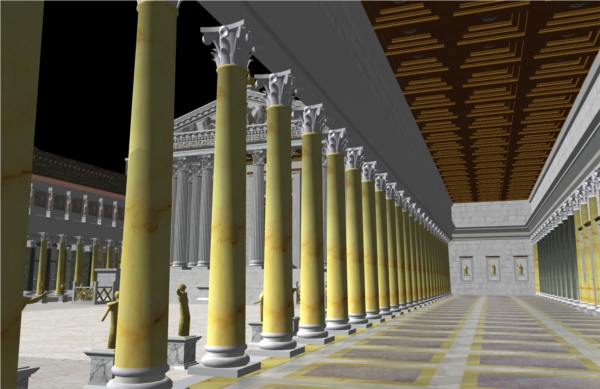Virtual Rome: Bringing the Eternal City to life
Dr Matthew Nicholls’ fascination with the Roman Empire began when he was just eight years old. Little did he know that his childhood passion for colouring in pictures of Romans in his Latin class would lead to the creation of a unique, award-winning digital model of Ancient Rome. Now, though, Nicholls’ 3D model of the Eternal City provides a view of the entire city, from any angle, at any time of day.
3D constructions illustrating the past
“My doctoral research was on books, libraries and intellectual culture in the Roman Empire,” says Dr Nicholls, who is Reading’s Associate Professor of Classics. “My research kept bringing me back to buildings, and I realised their importance in the ancient world.” And so Nicholls began to focus more on the ruins of the ancient world, creating 3D constructions to tell their stories and illustrate the past.
First came models of Rome’s libraries, and then, after a decade of intensive work, the world’s most detailed digital model of Rome itself. Nicholls’ model of Rome is dated c. AD 315 and is rooted in archaeological evidence, making it at close to the original as possible. The model contains thousands of buildings, including reconstructions of all the major monuments (such as the Colosseum, Palatine hill and the Forum) as well as the many square miles of ordinary housing, tombs, and commercial buildings.
Growing popularity worldwide
Virtual Rome, a digital modelling project involving undergraduate and postgraduate students, is now a popular optional module in the University’s Classics department. The historically accurate 3D digital model can be used to generate animations and 360-degree panoramic images, or viewed alongside contemporary images of Rome’s archaeological sites.
Virtual Rome was popularised by an innovative free, five-week MOOC on the FutureLearn platform. It is the world’s first live deployment of 3D content that can be manipulated by the user within a MOOC, and had attracted 23000 learners globally, by March 2018. The course was named by ClassCentral as one of the top ten most popular MOOCs worldwide in March 2017. It is anticipated that the MOOC will be repeated two to three times a year.
Promoting Virtual Rome – and a new project closer to home
Dr Nicholls has used blogs, workshops, videos, media appearances, commercial licensing and books to promote Virtual Rome, helping to popularise Classics, illustrate the educative benefits of knowledge of the ancient world, contribute to pedagogical innovation and provide humanities students with transferable skills.
Now he is also turning his attention to Silchester, working with third-year undergraduate students to create a 3D model of the Roman town in Hampshire, just 10 miles south of Reading.
Fast Facts
- Thanks to the University of Reading’s MOOC (Massive Open Online Course), tens of thousands of people around the world have accessed the virtual city
- Virtual Rome also won the Guardian and Higher Education Academy’s 2014 University Award for Teaching Excellence
- The British Academy ‘Rising Star’ Engagement Award has also honoured Dr Nicholls’ work in digital history
- Dr Nicholls won a National Teaching Fellowship in 2017, the UK’s highest award for university teaching excellence

